The
concept Verb table of the 3rd millennium comprises
two new products:
-
The Verb table of the 3rd millennium
(the current version is in French and is called: Excellez en conjugaison grâce au tableau de
conjugaison du 3ème millénaire -
dedicated
website: www.verbforms.com)
-
The 222 French verb table fast track
(dedicated
website:
www.conjugation.biz).
Their
content is almost identical: 222 verbs to be fully
conjugated with a stem table and an
ending table and a notice of use.
However, the stem table is presented:
-
on a A3-size
laminated card (29,7 cm X 42 cm) in
Excellez en
conjugaison grâce au tableau de
conjugaison du 3ème millénaire;
-
on a double-sided
laminated track of 60 cm X 9 cm in
the 222 French verb table fast track.
The verb table
of the third millennium
The verb
tables of the third millennium enable you to get all the
forms of 222 verbs in all eleven simple tenses of the
French conjugation thanks to the association of the elements of two
unique tables.
These tables illustrated below are:
On the stem table, you will also find the past-participle of these verbs
to form all the compound tenses.
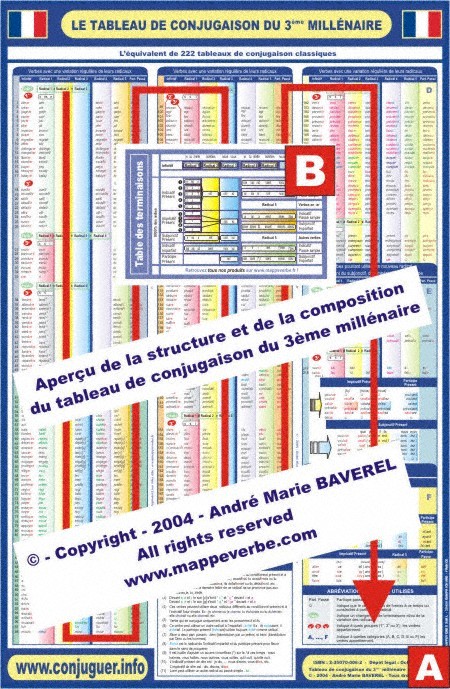
Photo non contractuelle
Main
advantages:
222 verbs
immediately accessible at a glance.
All that is superfluous was removed, which considerably reduces what
is left for you to learn.
An intuitive learning of many rules: you spontaneously learn,
for example, that a verb is made of two key elements (the
stem and the ending). Indeed, there is a map-like support adapted to each
one of these element and they are separate.
A double organization of
the verbs:
-
by group (1st conjugation, 2nd
conjugation and 3rd) according to the
infinitive ending,
-
and especially in six categories, according to the
stem variation, to structure your memory perfectly.
A new order of subject pronouns (je, tu, il, ils, nous, vous)
to remove any hesitations you may have and to facilitate
your pronunciation.
A systematic approach to put an end to multiple
exceptions and hundreds of irregular verbs.
Mode
of use:
or
The stems will appear
next to the corresponding endings
through a window cut out on the cursor. Then, you only need
to associate them to reconstitute the totality of the
selected verb forms .
THE
CLASSICAL VERB TABLE
The classical
verb table generally presents the 46 forms of a verb on a
same page as in the example below. You need 222 tables
of such type to get the equivalent of the Verb table of the
third millennium.
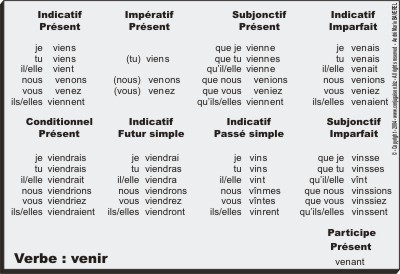
Now discover an outline of the seven steps which have enabled me
to reduce 222 classical verb tables in the Verb table of the
third millennium.
THE SEVEN STEPS TOWARDS
The verb table
of the third millennium
Step 1:
Change of the subject pronoun order
In the table
below, the forms are re-ordered according to je, tu, il,
ils, nous, vous.
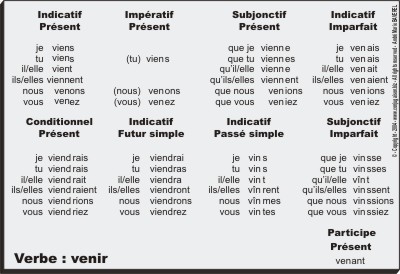
Step 2:
Outline of the form key elements (stems and endings)
In the table
below, stems and ending appear in two different colours.
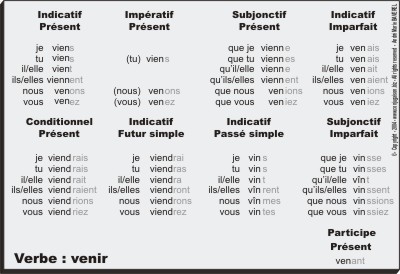
Step 3: Outline of places where the stem may change
The table below
shows the different places where a change of stem may occur.
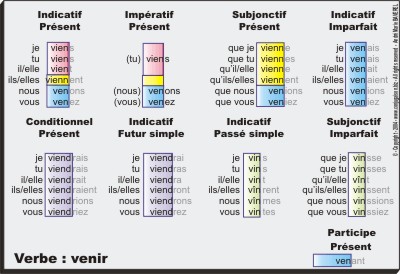
Step 4: Separation of stems and endings
In the table
below, all stems (radicaux) and endings
(terminaisons) are grouped in two different sets.
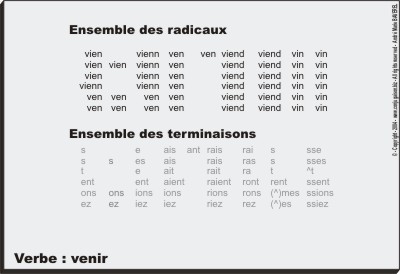
Step
5 :
Creation of an ending table
From the
whole of all French verbs endings, an ending table
was created. It presents a full list of
endings for 99,99% of French verbs. The structure of this table
and the organization of the endings on it have been optimized in
the following way:
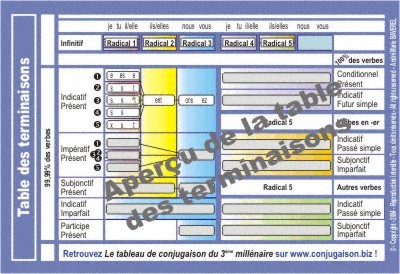
Non legal binding image
Step 5bis : Creation of a stem table
From the
whole of the stems of the 222 selected verbs, including in
particular all irregular verbs, and after removal of the
doublets, the table (A) shown at the beginning of this page was
created. Here are the relevant elements it contains
for the verb "venir" (to come):

Step 5ter : Creation of a parallel structure
In teh same time, a parallel structure was placed over the two tables to
facilitate the association of their elements. It allows to
visualize the tense formation rules by the use of
colours and geometrical forms (lines, columns, blocks). Indeed,
the elements which are to be assembled are laid out, in each
table, on same coloured zones. Thus, the stem viend
being used to form the conditionnel présent and the
corresponding endings rais, rais, rait..., riez are
laid out on same violet coloured zones.
Thus these zones were organized according to tense formation
rules and were laid out so as to create a structure which is
perfectly imbricated, like in a building set.
Step 7: Dynamic reconstitution of all the conjugated
forms
The structure and the composition of these tables allow a
dynamic and creative learning of all the conjugated forms.
They respect the dynamics of the brain which tend to
separate information of different nature (for example stem
and ending), and to connect them thanks to exclusive "connectors"
(the same coloured zones or blocks).
You will naturally reproduce this dynamic operation by
learning verb forms with this table.